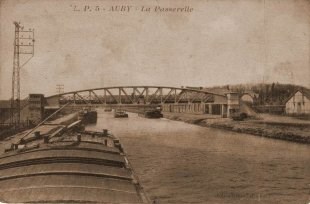 Raymond Normand was born on November 14, 1919 (the same day and month as Claude Monet, he said jokingly) in Auby, a small industrial town in the North of France, located near Douai, in a valley where the Canal of the Deûle takes its course. He was the second child of Maria Duhem and Just Normand, who already had a daughter, Jeanne, five years older than he. His father had been a miner until he came back seriously injured from WWI. Still he managed to work as an electrician. Raymond spent his first ten years in Flers-en-Escrebieux, two miles away from his birthplace, in a flat, marshy region known for agriculture and mining. However, the best moments of his life were the ones he spent in that dull and rainy environment, living on the countryside in contact with nature, peasants, and house animals.
Raymond Normand was born on November 14, 1919 (the same day and month as Claude Monet, he said jokingly) in Auby, a small industrial town in the North of France, located near Douai, in a valley where the Canal of the Deûle takes its course. He was the second child of Maria Duhem and Just Normand, who already had a daughter, Jeanne, five years older than he. His father had been a miner until he came back seriously injured from WWI. Still he managed to work as an electrician. Raymond spent his first ten years in Flers-en-Escrebieux, two miles away from his birthplace, in a flat, marshy region known for agriculture and mining. However, the best moments of his life were the ones he spent in that dull and rainy environment, living on the countryside in contact with nature, peasants, and house animals.
From his very early years, he expressed a fervent passion for drawing and painting. His schoolteachers bought him some pencils and drawing paper so that he could practice his talent. Back in Auby he attended the high school and the Art School in Douai where he was soon spotted for his artistic talents and was awarded many prizes. However, in 1934, at the age of fifteen, he was forced to interrupt his studies because of a serious bone disease (osteomyelitis) which kept him bedridden for two years. Although he had undergone several surgeries, he had to cope with the aftereffects for the rest of his life. It was during that period that he particularly enjoyed reading. Following his convalescence, he decided to leave the high school in order to dedicate himself full-time to his studies at the Art School in Douai. He then won a golden medal at an exhibition in Lille.
However, because of their son’s health, his parents decided to take him to the South of France while Jeanne, their married daughter, stayed in the North. They settled in Marseilles in 1937, and there, until 1941, Raymond attended sculpture and drawing classes at the Art School where César Baldaccini, the famous French sculptor, was also a student. Then Raymond accepted several odd jobs, such as making “santons” (small terracotta figurines in Provence), pots for cosmetics, sculptures to decorate façades of buildings. At the same time, before leaving for Paris, César worked in the lumber business and as a driving instructor. As it turned out, both artists kept in contact despite the sculptor’s celebrity and the different directions into which their art evolved.
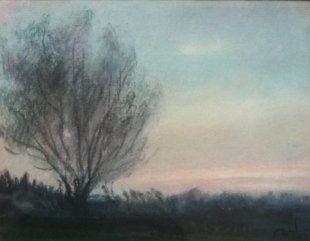 In 1943, Raymond Normand was sent to Germany to comply with Compulsory Labor Service. Due to his leg problem, he was assigned a job in an office. After his return to France, he worked for farmers and looked after herds of goats in Lambesc, in the “Bonrecueil” area, near Salon-de-Provence. At that time, his family was living in Grans, not far from the “Marie-Rose fountain”. It was during that period that he discovered the natural beauty of the Provence, just as Vincent Van Gogh had done in Arles. This southern part of France was very different from the flat and dull region where Raymond had spent his childhood. Following in the footsteps of the Impressionists, he grew more and more eager to captivate on canvas the vibrating light and colors that dazzled the aspiring painter from the North for the rest of his life.
In 1943, Raymond Normand was sent to Germany to comply with Compulsory Labor Service. Due to his leg problem, he was assigned a job in an office. After his return to France, he worked for farmers and looked after herds of goats in Lambesc, in the “Bonrecueil” area, near Salon-de-Provence. At that time, his family was living in Grans, not far from the “Marie-Rose fountain”. It was during that period that he discovered the natural beauty of the Provence, just as Vincent Van Gogh had done in Arles. This southern part of France was very different from the flat and dull region where Raymond had spent his childhood. Following in the footsteps of the Impressionists, he grew more and more eager to captivate on canvas the vibrating light and colors that dazzled the aspiring painter from the North for the rest of his life.
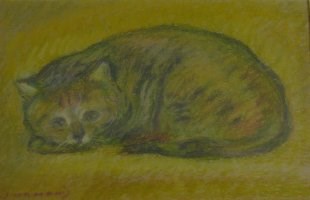 In 1950, he settled in Ventabren, not far from Aix-en-Provence. He devoted the remainder of his years to his art, while living with his parents and cats. With the help of his father, he built a small house at the bottom of the village, among pine and olive trees, in a peaceful area called the “Trou du Loup” (Wolf’s Hole). The bricks they used for the construction of the house were made by their own hands, and father and son had to carry the water from the Arc River on their backs. They eventually dug a well and set up a cistern to collect rain water used for domestic purposes. For many years there was no electricity or running water in the house. A workshop close to this humble abode allowed the painter to retire to his own world. Both men grew their own vegetables, thereby allowing the three members of the family to live on an almost vegetarian diet, with olive oil from their olive trees, wine from their vineyard, and milk from their goats. It was in this peaceful retreat that Raymond could, day after day, build up his remarkable works, first from nature and later on, when he had become too old to walk around, from sketches drawn on location at an earlier period.
In 1950, he settled in Ventabren, not far from Aix-en-Provence. He devoted the remainder of his years to his art, while living with his parents and cats. With the help of his father, he built a small house at the bottom of the village, among pine and olive trees, in a peaceful area called the “Trou du Loup” (Wolf’s Hole). The bricks they used for the construction of the house were made by their own hands, and father and son had to carry the water from the Arc River on their backs. They eventually dug a well and set up a cistern to collect rain water used for domestic purposes. For many years there was no electricity or running water in the house. A workshop close to this humble abode allowed the painter to retire to his own world. Both men grew their own vegetables, thereby allowing the three members of the family to live on an almost vegetarian diet, with olive oil from their olive trees, wine from their vineyard, and milk from their goats. It was in this peaceful retreat that Raymond could, day after day, build up his remarkable works, first from nature and later on, when he had become too old to walk around, from sketches drawn on location at an earlier period.
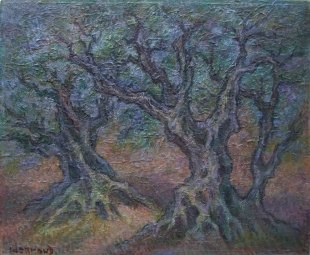 His paintings of hundred-year-old olive and almond trees with gnarled trunks, and pine trees tortured by the Mistral wind, as well as his Chinese ink images covering the same topics, reflect his gift for sculpture. But the fine and firm lines of his Chinese ink works also express the incredible talent of an exceptional drawer. Normand is mainly a landscape painter whose wide range of colors, delicate and sharp in turn or violent depending on his spirit, depicts the vibrating light and life of an unspoiled, original, and pure nature, or of a nature shaped by the labor of peasants in the old days and still untouched by urbanization, as the seasons and different hours of the day go by. His palette knife or brush oil paintings, his dry and soft oil pastels, his Chinese pen or stick ink works and his wash-drawings range from the countryside of Lambesc or Grans and the banks of the Touloubre River to the village of Ventabren and its surroundings, the banks of the Arc River, hills crisscrossed by some deserted paths, plains with some scattered old farms or “cabanons” (small stone sheds in Provence), planted with wheat, olive and almond trees, vineyards, cypresses, with patches of poppies, trees blossoming in the spring and turning golden in the autumn.
His paintings of hundred-year-old olive and almond trees with gnarled trunks, and pine trees tortured by the Mistral wind, as well as his Chinese ink images covering the same topics, reflect his gift for sculpture. But the fine and firm lines of his Chinese ink works also express the incredible talent of an exceptional drawer. Normand is mainly a landscape painter whose wide range of colors, delicate and sharp in turn or violent depending on his spirit, depicts the vibrating light and life of an unspoiled, original, and pure nature, or of a nature shaped by the labor of peasants in the old days and still untouched by urbanization, as the seasons and different hours of the day go by. His palette knife or brush oil paintings, his dry and soft oil pastels, his Chinese pen or stick ink works and his wash-drawings range from the countryside of Lambesc or Grans and the banks of the Touloubre River to the village of Ventabren and its surroundings, the banks of the Arc River, hills crisscrossed by some deserted paths, plains with some scattered old farms or “cabanons” (small stone sheds in Provence), planted with wheat, olive and almond trees, vineyards, cypresses, with patches of poppies, trees blossoming in the spring and turning golden in the autumn.
The skies he painted express the bitter winters with the Mistral wind, the scorching sun, the torpid summers, and the evening peace felt in the blazing sunset. Apart from self-portraits, he also painted some portraits of his mother, father, family, and friends. House animals (cats and goats of all ages), as well as large pastoral scenes with unreal characters, and sometimes a few caricatures also became the theme of his works.
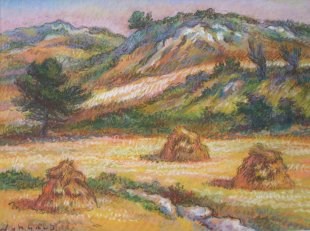 Raymond Normand dedicated his life to painting from the motif or in his workshop, reading, listening to music or to the news first on an old galena radio set, then on a transistor, gardening and looking after the property. He was regularly walking the steep path of “Lacan” up to the village to get some books from the “bibliobus” (library bus) or the local library. Thus he became a very cultured man able to have long talks with his visitors. Though he lived away from the world, he never stayed alone because he was living with his mother and father who died in 1974 and 1978 respectively. Then, when his sister retired, she came and lived for twenty years at Ventabren with her husband. During that period, she showed him a lot of affection. In 1993, she left again for the North of France to spend the rest of her life with her children. Moreover, many friends from different regions and professional backgrounds were coming all the time to visit him. First his colleagues from the Art School, then his local friends, then all those coming from Aix and Marseilles, as well as from the whole area, the Var, the Vaucluse, the Alps, and from even further away stayed with him in his workshop. They talked with passion, sitting near the wood stove on cold days or in the shade of the grape arbor or fig trees on pleasant days. They discussed many different topics ranging from current events to major developments, from work in the fields and animals to literature and history, sculpture and painting, music, religion, philosophy and so on. The topics differed depending on people’s mood, passions or occupations: schoolteachers or professors, farmers or shepherds, doctors or engineers, university or high school students, architects or sculptors, potters or poets, “santonniers” (makers of “santons”) or painters who asked for some advice, musicians who sometimes brought their instruments along to give an unexpected recital… And time to leave the premises was always coming too soon. Most often it was dark when the guests had to leave. They always departed enriched by this open-minded singular host, cheered by his hospitality, still fascinated by the beauty of his works. And when getting ready to leave with one of the host’s paintings, a friend had to negotiate hard to pay a decent price and not to receive the art work for free, out of friendship. In the course of time, a lot of art collectors from France and abroad came to the “Trou du Loup” to buy works for Belgium, Luxembourg, Germany, Italy, Greece, Spain, Portugal, North and South America, Africa, islands in the Indian Ocean… Even though he did not want to be popular, Raymond Normand actually acquired some fame.
Raymond Normand dedicated his life to painting from the motif or in his workshop, reading, listening to music or to the news first on an old galena radio set, then on a transistor, gardening and looking after the property. He was regularly walking the steep path of “Lacan” up to the village to get some books from the “bibliobus” (library bus) or the local library. Thus he became a very cultured man able to have long talks with his visitors. Though he lived away from the world, he never stayed alone because he was living with his mother and father who died in 1974 and 1978 respectively. Then, when his sister retired, she came and lived for twenty years at Ventabren with her husband. During that period, she showed him a lot of affection. In 1993, she left again for the North of France to spend the rest of her life with her children. Moreover, many friends from different regions and professional backgrounds were coming all the time to visit him. First his colleagues from the Art School, then his local friends, then all those coming from Aix and Marseilles, as well as from the whole area, the Var, the Vaucluse, the Alps, and from even further away stayed with him in his workshop. They talked with passion, sitting near the wood stove on cold days or in the shade of the grape arbor or fig trees on pleasant days. They discussed many different topics ranging from current events to major developments, from work in the fields and animals to literature and history, sculpture and painting, music, religion, philosophy and so on. The topics differed depending on people’s mood, passions or occupations: schoolteachers or professors, farmers or shepherds, doctors or engineers, university or high school students, architects or sculptors, potters or poets, “santonniers” (makers of “santons”) or painters who asked for some advice, musicians who sometimes brought their instruments along to give an unexpected recital… And time to leave the premises was always coming too soon. Most often it was dark when the guests had to leave. They always departed enriched by this open-minded singular host, cheered by his hospitality, still fascinated by the beauty of his works. And when getting ready to leave with one of the host’s paintings, a friend had to negotiate hard to pay a decent price and not to receive the art work for free, out of friendship. In the course of time, a lot of art collectors from France and abroad came to the “Trou du Loup” to buy works for Belgium, Luxembourg, Germany, Italy, Greece, Spain, Portugal, North and South America, Africa, islands in the Indian Ocean… Even though he did not want to be popular, Raymond Normand actually acquired some fame.
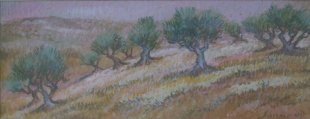 He sometimes displayed his works in his adopted village, at the “Amis des Arts” (Friends of Arts) or at the Tourist Information Center in Aix-en-Provence, at antique dealers or art galleries in Marseilles, in the Luberon, the Var… Critics always praised the artist for his true merits, without flattery or condescendence, as can be seen from the articles documented on this website. Many artists and art lovers, among them the French sculptor César Baldaccini and relatives of the Provençal painter Joseph Ravaisou and the historian and collector of photographs Michel F. Braive and the American painter James N. Rosenberg, admire him tremendously. Nevertheless, Raymond Normand remained humble in spite of his indisputable talent and refused pushing for success.
He sometimes displayed his works in his adopted village, at the “Amis des Arts” (Friends of Arts) or at the Tourist Information Center in Aix-en-Provence, at antique dealers or art galleries in Marseilles, in the Luberon, the Var… Critics always praised the artist for his true merits, without flattery or condescendence, as can be seen from the articles documented on this website. Many artists and art lovers, among them the French sculptor César Baldaccini and relatives of the Provençal painter Joseph Ravaisou and the historian and collector of photographs Michel F. Braive and the American painter James N. Rosenberg, admire him tremendously. Nevertheless, Raymond Normand remained humble in spite of his indisputable talent and refused pushing for success.
Raymond Normand died on March 12, 2000 in Aix-en-Provence. The Town Council of Ventabren, where he was buried, has inherited his properties and works. His life bears a certain resemblance to the existence of those suffering artists who received recognition only posthumously, beyond the deceptive mirror of the vanities of the world.
© Colette Dijoux, June 2008
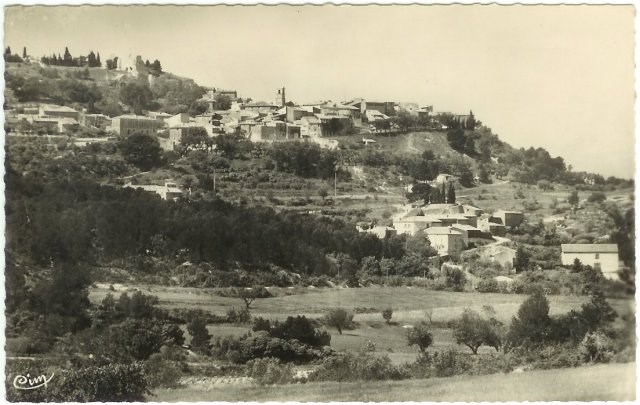
Photo: Ventabren during the 1950’s.